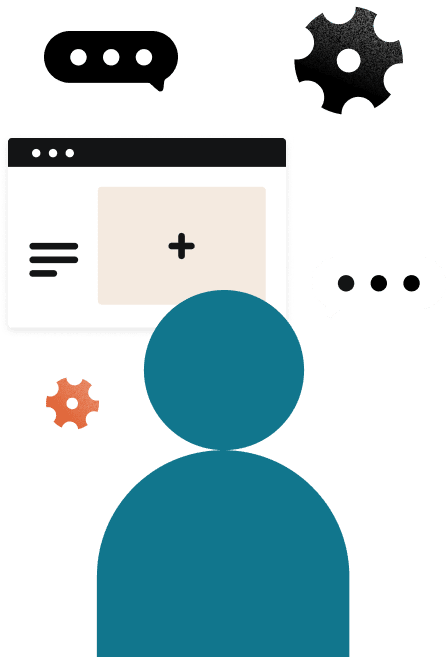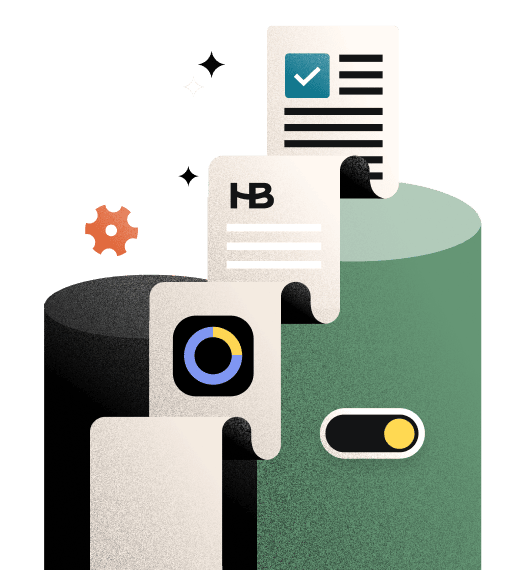Learn how to create your ideal client profile. Strategically target your audience and nurture qualified leads that make the most sense (and cents!) for your business.
I’ve run an independent business for over 14 years, so I can say from firsthand experience that your entire business changes when you understand your ideal client profile. But identifying your ideal client is easier said than done. In fact, you might be wondering where you should begin when it comes to defining who they are.
In the earlier stages of my business, I had no idea how to identify my ideal client. I was generating leads without focus and was willing to work with just about anyone to gain experience. I soon realized that wasn’t the best strategy — it left me exhausted, broke, and questioning if I was really cut out for being a business owner, especially without an effective sales strategy and reliable sales team.
But I was cut out for it, I just needed to know when to say “yes,” and when to say “no, thank you.”
It became clear that I needed to stop saying yes to every inquiry and instead find the clients best suited for my business. If you’re feeling overworked, overwhelmed, and over your business, it might be time to say goodbye to the wrong clients and start attracting more of the right ones that actually match your ideal client profile or ideal personas. Before we do that, let me explain what an ideal client is and why identifying them is essential.
Jump to:
- What is an ideal client?
- Why is it important to identify your ideal client?
- Understand who is not in your target audience
- Identify prospective customers you want to attract
- What are your ideal client’s problems?
- What are your ideal client’s values and desires?
- How to create a profile of your ideal client
What is an ideal client?
Businesses exist to solve problems for their clients. Your ideal client is the type of client your business was created to serve.
The term “ideal” can be misleading. An ideal client is not a unicorn person who is the perfect customer. Sadly, unicorns don’t exist. (Sad face, I know.) Your ideal client is a potential client with the combined attributes that complement what your business offers. You wouldn’t offer wedding photography services to a married couple, for example. You need to make sure you have a specific ideal client profile in mind so you can evaluate qualified leads and better service your clients once they’re booked.
As you set out to identify your ideal client, keep in mind that you’re not writing a dating profile for your customer that includes zero flaws and only perfection. Your marketing messages and marketing campaigns should reflect this. The people you want to work with have flaws, quirks, and personality traits that are not always the best—they’re human! But, aside from all of that, they are *your* people.
Why it is important to identify your ideal customers
1 in 5 businesses fails within the first 18 months. That’s a pretty sobering statistic. One of the reasons these businesses fail is that businesses often don’t know their ideal audience or which clients to target. You need to identify your prospective clients so that you can create strategies to market, sell, and serve that specific target customer.
From there, go a step further and focus on what problem your independent business solves and what your ideal client values most about the work you do. Once you understand who your ideal client is—their personality, problems, values, and more—you can begin to position your business in front of them.
Make business easy for you and your customers
One way you can position yourself for success every time is by assessing and streamlining your clientflow. Your clientflow comprises everything from the business admin tasks you do on the back end, to the client’s experience when finding you, to signing the contract, to receiving the service.
If your ideal client is tech-savvy and pays with a credit card in full, send a contract, invoice, and request payment in a single secure email. This makes the exchange seamless for your customer and helps you get paid faster.
Essentially, your entire clientflow, from the business plan to the buying process, should be designed to offer solutions for your ideal client’s pain points while making your job as easy as a few clicks. Once you have that focus, the next step is reaching the types of clients you want.
Understand who is not your target audience
Imagine no longer wasting time in email threads that go on forever, or being on consultation calls that go nowhere. As you start to create your ideal client profile, it’s easier to think about your ideal client persona, and who you no longer want to work with (or who not to take calls with). Remember when I told you that it’s okay to say no to clients you don’t want to work with anymore?
These are those people. It’s time for you to decide who you’ll say goodbye to so that you can stop serving the clients who don’t serve you. Once you identify clients who are not a good fit for you, you can transition to supporting them in finding a better fit. You can do all this while freeing up time for more dreamy customers and perfecting your business niche.
This is your opportunity to get very specific about who you no longer want to work with. Specific clients might be the wrong fit (aka not your ideal client) for your products and services based on the project itself, their budget, or even particular personality quirks. This is the first step to calling in those dreamy, high-end customers you’re dying to work with. Here are two action items to help you through this exercise:
- Identify past clients who were the wrong fit, and investigate what went wrong
- Identify red flags, deal-breakers, and non-starters based on experience
Identify prospective ideal clients you want to attract
Now that we know who we no longer want to work with, it’s time to describe the ideal client that we do want to work with. What’s their budget, style, and current circumstance? We want to determine if they’re the client whose problems your business is designed to solve and build an ideal client profile.
The best way to attract clients who are a great fit for your business is to get specific and identify your niche. Start with this list of questions to figure out who your ideal client is:
- What is their budget for the service they’re looking for?
- Where do they live and work?
- What types of activities do they do for fun?
- How do they spend their free time?
- What values do they hold that align with my own?
- Am I appealing to a specific niche in my industry?
- What is their background story and buying behavior?
These are great starter questions that give you the characteristics and traits of ideal clients you should focus on marketing toward.
What are your ideal client’s problems?
To better serve your customers and land sales, you have to understand your ideal client’s pain points and how you can address them.
You and your business offerings are the solution to their problems. By understanding them and their point of view, you’ll be able to offer the services that your perfect clients will be eager to purchase. Your services become the remedy to their biggest pain point.
This is the best way for you to show up and serve your clients better than any competitor. By stepping into their shoes and solving your customer’s exact problems, you’ll also turn them into brand advocates and build a reliable referral pipeline for your business. To tailor your services to your ideal clients, ask yourself these basic questions:
- What problems are my ideal clients currently facing that need to be solved?
- What do those problems feel like? For instance, how do they manifest in their life? Describe those problems in as much detail as you can.
- How does my business solve these problems?
Pro tip: Data-mine for insights about your ideal client, using testimonials, reviews, consultations, and interviews to shed light on the questions above.
What are your ideal client’s values and desires?
Every client who submits an inquiry desires something from you and also values something about your service.
Now that we understand your ideal client’s problems and how your business solves them, let’s talk about what they ultimately desire from you and what values guide them in making the purchasing decision. The easiest way to do this is to answer the following prompts:
- What would your client’s ideal life be like if this problem didn’t exist?
- Finish this sentence: Because of the problem my client is experiencing, they’re feeling ________. But once this problem is solved, my ideal client will feel _________.
- Aside from solving their problems, what experience do they ultimately desire working with a company like mine?
- What does the client value most about the work we do?
The more thought you put into empathizing with your ideal client’s situation, the clearer your ideal client profile becomes.
Don’t be so hard on yourself and don’t expect yourself to have the “right” answer to every question. Instead, get curious about how your ideal client personas think and feel. Stay committed to understanding how their personalities, problems, and desires might change over time.
Pro tip: To define all these characteristics, take a look at your existing customers. Which ones didn’t work out? Which ones had the most successful projects? You can also conduct market research to get broader data on your target audiences.
How to create an ideal client profile in four steps
Creating an Ideal Client Profile (ICP) is essential for any business looking to attract the right clients and grow effectively. Follow these four easy steps to develop a clear and actionable ICP.
Step 1: Identify which clients are not your ideal clients
- Before you decide who you want to attract, get clear on which customers are not the right fit for your business. This will give you a boost in understanding who you do want to attract.
- Example: For a boutique marketing agency, non-ideal clients might be those looking for low-cost, high-volume services rather than high-quality, tailored strategies.
Step2: Identify who you want to attract
- Now that you know who you don’t want to attract, you can figure out who you do. What’s your target demographic? And what do facts suggest about who your target demographic is and what they value?
- Example: The ideal clients for the boutique marketing agency might be mid-sized businesses in the tech industry that value personalized marketing strategies and are willing to invest in long-term partnerships.
Step 3: Identify your ideal client’s problems
- Businesses exist to solve their customers’ problems. What problems does your ideal client face, and how do you provide the solution?
- Example: The ideal clients face challenges in differentiating themselves in a crowded market and require innovative marketing solutions to stand out. The agency provides customized strategies and creative campaigns to address these issues.
Step 4: Identify your ideal client’s desires and values
- To serve your customers better and land those sales, you have to understand what they value and desire from you.
- Example: The ideal clients value high-quality, creative work, transparency in communication, and measurable results from their marketing efforts. They desire a partnership with a marketing agency that understands their industry and can provide innovative solutions.
Example ideal client profile
Business type: Boutique marketing agency
Non-ideal clients:
- Small businesses looking for low-cost, high-volume services
- Clients who prioritize price over quality
- Businesses outside the tech industry
Ideal clients:
- Industry: Mid-sized tech companies
- Demographics: Companies with 50-200 employees, annual revenue between $5M and $50M
- Geographic location: Primarily based in North America and Europe
Client problems:
- Difficulty standing out in a saturated market
- Lack of innovative marketing strategies
- Need for personalized and creative marketing solutions
Client desires and values:
- High-quality, creative marketing work
- Transparency and effective communication
- Measurable results and ROI from marketing efforts
- Long-term partnership with a marketing agency
- Industry-specific knowledge and innovative solutions
By following these steps and using the example provided, you can create a detailed and actionable ideal client profile that helps attract the right clients to your business.
Leverage your ideal client profile
Now that you know how to identify your ideal client, it’s time to reach them through digital marketing. Use the ideal client profile throughout your lead generation funnel and your sales pipeline so you can make sure you don’t spend time nurturing leads who are unlikely to convert. Start with your marketing efforts, including content for social media channels and your website. Be precise with your marketing budget. Create content that speaks directly to your ideal customer. From there, make sure you’re using your ICP during your discovery calls to ensure you’re only moving qualified leads forward in your sales process.
Are you a wedding pro and want my help understanding your ideal client profile? Check out The Client Cocktail, my secret recipe for wedding pros who want to book high-end clients in the wedding industry. The Client Cocktail is a client attraction formula for wedding planners, photographers, and industry creatives who are ready to upgrade their clients (and stop serving the wrong people). In just one day, you can map out your ideal client avatar with my help.




